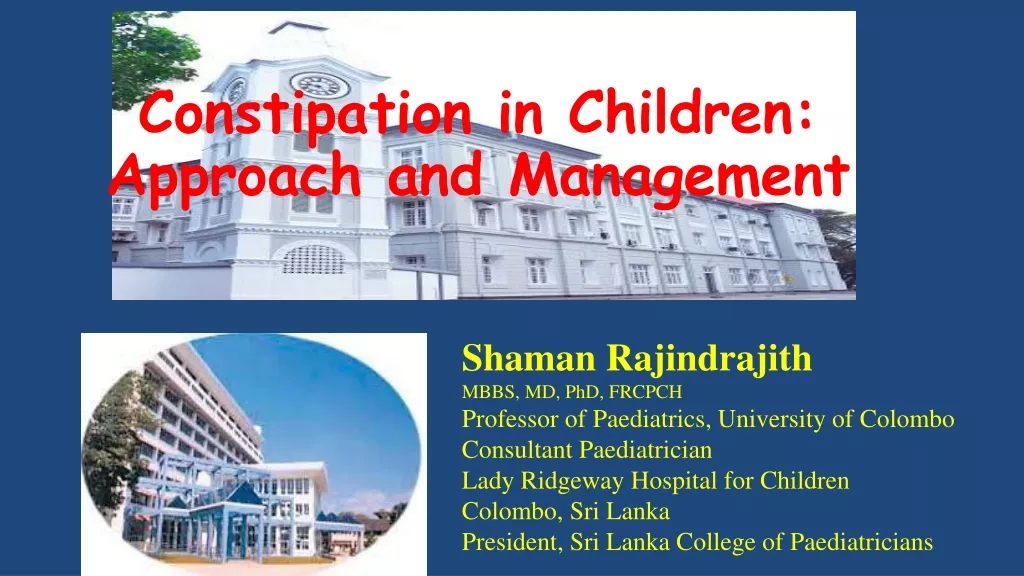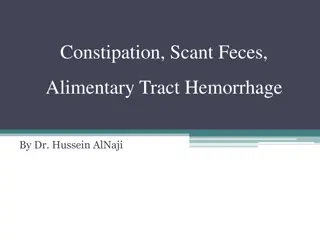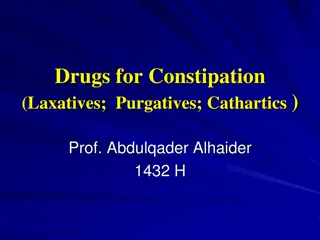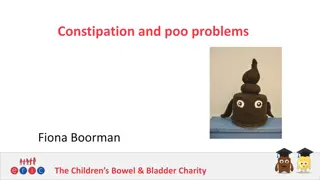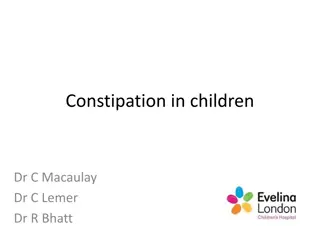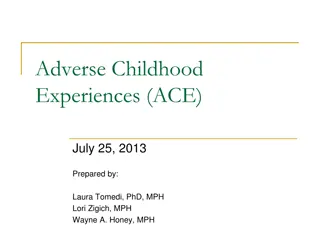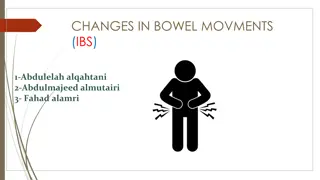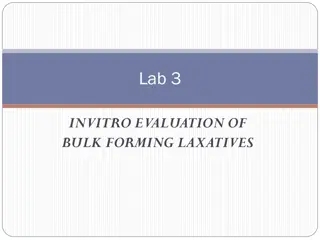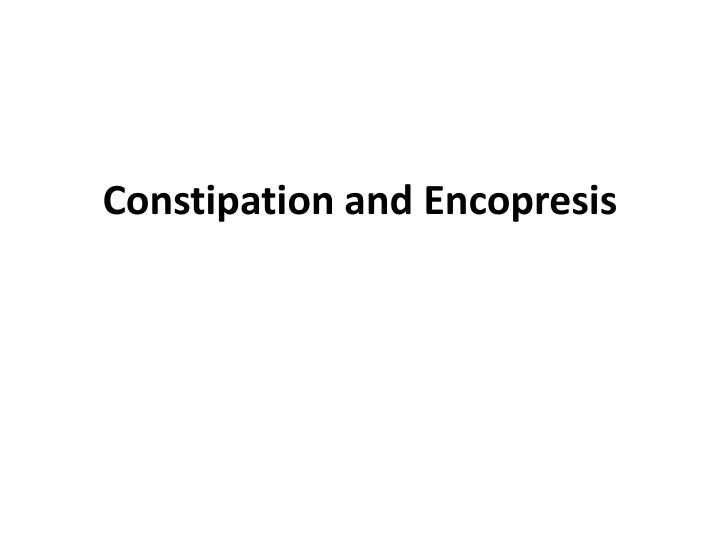
Childhood Constipation and Encopresis
Constipation is a common issue in childhood characterized by infrequent bowel movements and hard stools. Encopresis, a condition where retained stool leads to fecal incontinence, is often associated with constipation in children. Functional constipation is a typical pattern, with symptoms such as withholding stool and painful defecation. Other potential causes include Hirschsprung disease and various systemic disorders affecting metabolism or muscle function.
Download Presentation

Please find below an Image/Link to download the presentation.
The content on the website is provided AS IS for your information and personal use only. It may not be sold, licensed, or shared on other websites without obtaining consent from the author. If you encounter any issues during the download, it is possible that the publisher has removed the file from their server.
You are allowed to download the files provided on this website for personal or commercial use, subject to the condition that they are used lawfully. All files are the property of their respective owners.
The content on the website is provided AS IS for your information and personal use only. It may not be sold, licensed, or shared on other websites without obtaining consent from the author.
E N D
Presentation Transcript
Constipation Constipation is a common problem in childhood. When a child is thought to be constipated, his parents may be concerned about straining with defecation, hard stool consistency, large stool size, decreased stool frequency, fear of passing stools, or any combination of these. Physicians define constipation as two or fewer stools per week or passage of hard, pellet-like stools for at least 2 weeks. A common pattern of constipation is functional constipation, which is characterized by two or fewer stools per week, voluntary withholding of stool, and infrequent passage of large-diameter, often painful stools. Children with functional fecal retention often exhibit retentive posturing (standing or sitting with legs extended and stiff or crossed legs) and have associated fecal incontinence caused by leakage of retained stool (encopresis).
Differential Diagnosis Functional constipation commonly occurs during toilet training, when the child is unwilling to defecate on the toilet. Retained stool becomes harder and larger over time, leading to painful defecation. This aggravates voluntary withholding of stool, with perpetuation of the constipation.
Hirschsprung disease is characterized by delayed meconium passage in newborns, abdominal distention, vomiting, occasional fever, and foul-smelling stools. This condition is caused by failure of ganglion cells to migrate into the distal bowel, resulting in spasm and functional obstruction of the aganglionic segment. Only about 6% of infants with Hirschsprung disease pass meconium in the first 24 hours of life, compared with 95% of normal infants. Most affected babies rapidly become ill with symptoms of enterocolitis or obstruction. Affected older children do not pass large-caliber stools because of rectal spasm, and they do not have encopresis. Other causes of constipation include spinal cord abnormalities, hypothyroidism, drugs, cystic fibrosis, and anorectal malformations A variety of systemic disorders affecting metabolism or muscle function can result in constipation. Children with developmental disabilities have a great propensity for constipation because of diminished capacity to cooperate with toileting, reduced effort or control of pelvic floor muscles during defecation, and diminished perception of the need to pass stool.
Distinguishing Features Congenital malformations usually cause symptoms from birth. Functional constipation is overwhelmingly the most common diagnosis in older patients. Constipation in older children often begins after starting school, when free and private access to toilets may be restricted. Use of some drugs, especially opiates and some psychotropic medications, also is associated with constipation. For a few specific causes of constipation, directed diagnostic testing can make the diagnosis. A narrowed, aganglionic distal bowel and dilated proximal bowel on barium enema suggests Hirschsprung disease. Rectal suction biopsy confirms the absence of ganglion cells in the rectal submucosal plexus, with hypertrophy of nerve fibers. Lack of internal anal sphincter relaxation can be shown by anorectal manometry I Hirschsprung disease.
Hypothyroidism is diagnosed by examination and by thyroid function testing. Anorectal malformations are easily detected by rectal examination. Cystic fibrosis (meconium ileus) is diagnosed by sweat chloride determination or CFTR gene mutation analysis . Most children with constipation have functional constipation and do not have any laboratory abnormality. Examination reveals normal or reduced anal sphincter tone (owing to stretching by passage of large stools). Fecal impaction is usually present, but a large-caliber, empty rectum may be found if a stool has just been passed.
Evaluation and Treatment of Functional Constipation In most cases of constipation, the history is consistent with functional constipation absence of neonatal constipation, active fecal retention, and infrequent, large stools with soiling. In these patients, no testing other than a good physical examination is necessary. Young children with painful defecation must have a prolonged course of stool softener therapy to alleviate fear of defecation. The child should be asked to sit on the toilet for a few minutes on awakening in the morning and immediately after meals, when the colon is most active and it is easiest to pass a stool. Use of a positive reinforcement system for taking medication and sitting on the toilet is helpful for younger children. The stool softener chosen should be non habit forming, safe, and palatable. Polyethylene glycol and milk of magnesia are the most commonly used agents.

